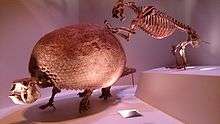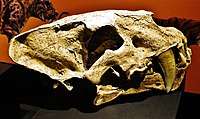Xenosmilus
Xenosmilus hodsonae (from Greek, ξένος, xenos, "strange" + σμίλη, smilē, "chisel" ) is an extinct member of the Machairodontinae, or saber-toothed cats. The species name hodsonae originates from Debra Hodson, the wife of a researcher.[1] Two fairly intact specimens were found by amateur fossil hunters in 1983 (1981 by some sources) in the Haile limestone mines in Alachua County, Florida. In 1994, the fossils were examined, and it was decided that the cats were of an entirely new genus.[2] The fossils were of Irvingtonian age (1.8 to 0.3 Ma).[3] Because the skeletons were found beside each other, some suspect Xenosmilus was a social mammal.[1] Found alongside the two skeletons were dozens of peccary bones. It seems likely, with their muscular builds, that X. hodsonae preyed upon peccaries. It has also been theorized by some to have hunted via a "bite and retreat" strategy using its teeth to inflict deep wounds because of the way its canines and incisors could operate as a unit during a bite, leading to Xenosmilus bearing the occasional moniker of "cookie-cutter cat".[4]

| Xenosmilus Temporal range: Irvingtonian | |
|---|---|
 | |
| X. hodsonae, Florida Museum of Natural History Fossil Hall at the University of Florida | |
| Scientific classification | |
| Kingdom: | Animalia |
| Phylum: | Chordata |
| Class: | Mammalia |
| Order: | Carnivora |
| Suborder: | Feliformia |
| Family: | Felidae |
| Subfamily: | †Machairodontinae |
| Tribe: | †Homotherini |
| Genus: | †Xenosmilus Martin et al., 2000 |
| Species | |
|
†Xenosmilus hodsonae | |
Physically, the cat measured between 1.7–1.8 m (5.6–5.9 ft) long with a highly muscular body and probably weighed around 230–400 kg (510–880 lb), making it similar in size to the fellow machairodonts Machairodus horribilis and Amphimachiarodus kabir. Only Smilodon populator was noticeably larger amongst the saber-toothed cats.
Before their discovery, all known saber-toothed cats fell into two general categories. Dirk toothed cats had long upper canines and stout legs. Scimitar toothed cats had only mildly elongated canines, and long legs. Xenosmilus broke these groupings by possessing both stout muscular legs and body, and short broad upper canines.[5] Unlike most other saber-toothed cats, all of Xenosmilus's teeth were serrated, not just its fangs and incisors. The way its top teeth were lined up also allowed Xenosmilus to concentrate its bite force on two teeth at a time.[1]
References
- "Xenosmilus is the grittier name for "cookie-cutter panda cat"". Coffee and Creatures. 2019-12-19. Retrieved 2020-06-27.
- Cookie-Cutter Cat Not as Cute as the Name Sounds, Wired
- Paleobiology Database: Xenosmilus, Age range and collections
- Anton, Mauricio (2013). Sabertooth.
- A more fearsome saber-toothed cat, ScienceNews, October 20, 2008
| Wikispecies has information related to Xenosmilus |
